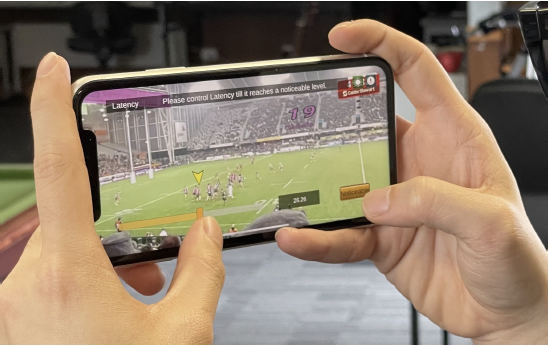Sports Visualization in the Wild:
The Impact of Technical Factors on User Experience in Augmented Reality Sports Spectating
Wei Hong Lo, University of Otago, Dunedin, New Zealand | Holger Regenbrecht, University of Otago, Dunedin, New Zealand | Stefanie Zollmann, University of Otago, Dunedin, New Zealand
As the realm of Augmented Reality (AR) expands into sports, understanding the technical factors that influence user experience becomes crucial. The study “Sports Visualization in the Wild” delves into how latency, registration accuracy, and jitter impact spectators' enjoyment during live sporting events. The researchers emphasize that “By understanding these factors, developers can optimize AR experiences…to ensure maximum enjoyment for users” (Lo et al., 2023). This highlights the potential for AR to enhance the sports experience when carefully engineered.
FIGURE 2. An illustration of technical factors evaluated: latency, registration accuracy, and jitter. Visualizations are shown in
blue (static) and orange (dynamic) where the arrow is targeting the person in yellow.
PROCEDURE
For the study, the participants experienced an indirect AR simulation of a rugby game. They completed three parts:
Optimal Conditions: Participants rated their user experience using a baseline AR scenario with ideal technical factors.
Factor Manipulation: Participants adjusted latency, registration accuracy, and jitter levels using sliders to identify noticeable and disruptive values, followed by ratings of the impact on their experience.
Compounded Factors: Participants experienced the AR simulation again with the previously identified noticeable values for all factors combined and provided additional ratings.
The study utilized 360° video of a live rugby game, and participants provided feedback via questionnaires after each phase (Lo et al., p.8).
FIGURE 4. User study session where a participant controls
a slider to manipulate the technical factor. The goal is to set
the slider until they obtain the noticeable and disruptive levels.
Shown in the image is latency.
Key Findings:
Latency is identified as the most disruptive factor affecting user experience. The study reveals, that “Latency had the highest negative impact on user experience,” particularly in dynamic environments like sports venues.
Registration Accuracy follows closely, influencing how well visualizations align with real-world actions. As stated, “Registration accuracy for dynamic content greatly impacted user experience.”
Jitter, although less impactful, still detracts from the overall experience. The study notes, “Jitter had the least impact on user experience compared to latency and registration accuracy.”
The combination of these technical factors can lead to compounded negative effects. The authors state, “User experience disruption appeared to be non-linear,” indicating that multiple issues can intensify frustrations for users (Lo et al., p.8).
Implications for Sprinters
The findings from this study have great implications for sprinters, especially in the development of AR training tools and applications. By minimizing latency and enhancing registration accuracy, AR systems can provide real-time feedback and situational awareness, vital for sprinters during training and competition. The ability to visualize performance metrics without disruptive technical hindrances can foster a more focused training environment, empowering athletes to refine their techniques and strategies effectively.
Lo, W. H., Regenbrecht, H., & Zollmann, S. (2023). Sports Visualization in the Wild: The Impact of Technical Factors on User Experience in Augmented Reality Sports Spectating. IEEE computer graphics and applications, 43(6), 64–74. https://doi.org/10.1109/MCG.2023.3308958



